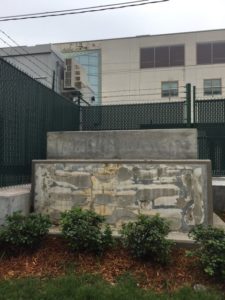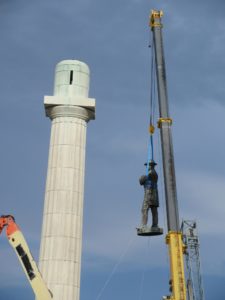Confederate Monument Controversy in New Orleans
Across the U.S. South and beyond, cities are debating the fate of their Confederate monuments. In New Orleans, the May 2017 removal of the Robert E. Lee monument in Lee Circle, the large round-about on St. Charles Avenue, was the culmination of over two years of public and political drama, driven primarily by Mayor Landrieu’s 2015 charge less than a week after the Charleston massacre to “look at the symbols in this city to see if they still have relevance for our future” (Times Picayune June 22, 2015). He explained that a conversation with jazz musician Wynton Marsalis, who when asked to help plan the city’s 2018 Tricentennial Celebration, challenged the mayor to consider Lee Circle through his eyes. “Who is he? What does he represent? And in that most prominent space in the city…does that space reflect who we were, who we want to be or who we are?” (Times Picayune June 24, 2015).
Landrieu proposed the removal of four monuments – statues of Robert E. Lee, P.G.T. Beauregard, Jefferson Davis, and the Battle of Liberty Place Obelisk. Dedicated between the years 1884 and 1915, these four monuments were erected as part of a national trend, particularly in the South, symbolizing the Confederacy’s Lost Cause mythology – a revisionist Civil War narrative intended to transform the South’s military defeat into a political and cultural victory, promoting white dominance and states’ rights, while deifying southern leaders (Gallagher and Nolan 2010).
Using a public nuisance law, the Mayor brought the issue to the city council that ultimately voted six to one to remove the monuments. Yet, unsurprisingly, the issue was far from resolved. While the Mayor’s office moved forward with plans for removal, pro-monument groups such as the Monumental Task Committee deployed multiple legal maneuverings to slow the process. Meanwhile, contractors bidding on the removal contract received death threats. Countless protests occurred, mostly in front of the three figurative memorials which became gathering places for supporters and opponents of removal. At times the protests were small and cordial; others were tense and required police barricades and security. Some were organized by anti-monument organizations such as Take ‘Em Down, Nola, and others by anti-removal groups like Save Our Circle, and still more were informal and grew from people walking by or patrons of local bars and restaurants coming out to engage. Not even during the city’s beloved Jazz Fest was there an escape from the controversy as a plane flew overhead with a banner reading “OUR MONUMENTS OUR HISTORY!”

After town hall meetings, hearings, lawsuits, appeals, and protesting, the uprooting of the Confederate statues in New Orleans began in the early morning hours of April 24th with no public notice of the removal. Because of serious security concerns, removal workers masked their faces as well as the company name on their vehicles and wore flak jackets. With snipers overhead in a parking garage, the workers took down the first monument, the Liberty Place obelisk behind a French Quarter shopping mall. Long a controversial monument, the Liberty Place obelisk honored those who fought against political integration of blacks into a white-controlled government (Gill 1997). The White League defeated the much smaller New Orleans’s police force, where 35 people, mostly police officers, died. Nevertheless, protestors rallied to demonstrate their disapproval of the obelisk’s removal.

About two weeks later, the statue of Confederate president Jefferson Davis at the intersection of Jefferson Davis Parkway and Canal Street was taken down in the pre-sunset hours of May 11th. Next, the P.G.T. Beauregard statue, erected at the entrance to City Park in 1915, was removed one week later, again in the morning hours, with a relatively calm crowd. At both sites, protestors for and against monument removal demonstrated, and while the scenes were heated, no physical injuries occurred.
Then on May 19th, in the light of day on a warm New Orleans afternoon, onlookers brought lawn chairs, held parasols while drinking mimosas, played Michael Jackson’s Remember the Time on a boom box; others danced as an impromptu jazz band sounded their instruments. This was the day that the most prominent of the four monuments, the Robert E. Lee northward facing bronzed statue, would be removed from its 60-foot column, where he had been standing for 133 years. This final of four Confederate statues removed seemed to resemble more of a tailgate party than a protest (Times Picayune May 19, 2017). However, contractors again wore masks and protective gear because of the highly contentious Confederate monument controversies. As a crane finally took the Lee statue down, the crowd of hundreds cheered and jeered. Here, New Orleans’s festive culture intersected with serious memory-work, highlighting that such work is always at its root local.
As Lee was descending, just a few blocks away New Orleans Mayor Mitch Landrieu was delivering the speech of a lifetime – now referred to as the Gallier Hall address after the venue where it occurred. (Read entire speech here.) Noted for its rhetorical eloquence engaging pathos, ethos, and logos, Mayor Landrieu’s speech reminded us that like monuments, words matter. Consider the following excerpt:
“America was the place where nearly 4,000 of our fellow citizens were lynched, 540 alone in Louisiana; where the courts enshrined ‘separate but equal’; where Freedom riders coming to New Orleans were beaten to a bloody pulp. So when people say to me that the monuments in question are history, well what I just described is real history as well, and it is the searing truth. And it immediately begs the questions: why there are no slave ship monuments, no prominent markers on public land to remember the lynchings or the slave blocks; nothing to remember this long chapter of our lives; the pain, the sacrifice, the same…all of it happening on the soil of New Orleans. So for those self-appointed defenders of history and the monuments, they are eerily silent on what amounts to this historical malfeasance, a lie by omission.”

The four monuments are now housed in an undisclosed location with the idea that they will be relocated to a museum where proper contextualizing and interpretation may be provided. Since the beginning of the process, Mayor Landrieu has advocated this as a solution, so that the city may remember but not revere the figures and events that they embody (Times Picayune July 9, 2015). Of course, these monuments are not the only controversial memorializations in New Orleans’s cultural landscape. Take ‘Em Down Nola is advocating for the removal of other monuments such as the Andrew Jackson statue in the beloved French Quarter’s Jackson Square. Jackson, victor at the Battle of New Orleans in the War of 1812, is hailed as the Savior of New Orleans but also a major contributor to the Trail of Tears. Indeed, difficult memory-work lies ahead for the city and the U.S. South as complex histories and how to remember those histories for the present and future continue to come to the fore.
As geographers visiting the city and no doubt partaking in its festive culture, you are also encouraged to walk by the sites where these statues were emplaced for well over a century and consider what is present in their absence—as of this writing, the pedestals of these Confederate monuments remain empty. We suggest that the now empty plinths where these statues once stood are signs of promise not despair. They are part of the process of memory-work that must occur to broaden one form of spatial justice in the landscape.
Jennifer Speights-Binet
Samford University
Rebecca Sheehan
Oklahoma State University
DOI: 10.14433/2017.0022
Gallagher, Gary W and Alan T. Nolan, eds. 2010. The Myth of the Lost Cause and Civil War History. Bloomington: Indiana University Press.
Gill, James, 1997. Lords of Misrule: Mardi Gras and the Politics of Race in New Orleans. Jackson: University Press of Mississippi.


